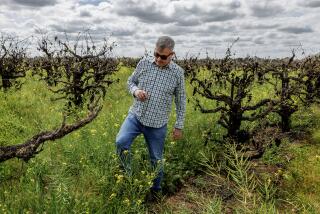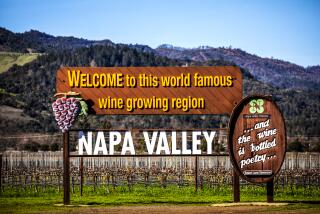Pssst! An Insider’s Shopping List
Wine writing, like stock picking, has a curious aura. In the middle of innocuous chit-chat at parties, a newfound acquaintance will lower his voice and ask conspiratorially, “So what do you really recommend?”
I’m always a little taken aback when this happens. In wine, as in the stock market, there’s a sense that the insiders get one deal and the rest of us get the scraps. Maybe that’s true in the money world, but it’s not so in the wine world. There really aren’t any hidden secrets or insider trades.
Yes, it’s true that you’re not going to read--at least not in a big newspaper--about a wine issued in one-barrel (300 bottles) quantities, like some oddball Burgundy. It’s hardly worth discussing, given the quantity. So, sure, there’s always some esoterica that isn’t swept up in the net. But such wines are so few that you can count them without taking off your shoes.
Which brings me to the conspiratorial nudge-and-wink treatment at parties: I really do recommend what I write about. Worse (for my bank account) I often buy what I recommend. Suffice it to say that the following wines really are, well . . . recommended.
*
1994 Fattoria Selvapiana Chianti Rufina ($11.95): Although the name seems all-embracing, Tuscany’s Chianti region is divided into six zones, all of which commonly employ the name Chianti. The most famous of these--and arguably the best--is Chianti Classico.
One other zone, however, is worth remembering: Chianti Rufina (pronounced ROO-feen-ah). East of Florence, the Rufina zone is the smallest of the Chianti namesakes. Rufina once was seen as one of the finest districts in Tuscany because its vineyards, which climb the steep sides of the Apennines mountains, are on stony soil with significant amounts of limestone and clay.
In recent years, though, Chianti Rufina is all but forgotten, because it has only a handful of producers. Granted, it does have the powerhouse Frescobaldi family, which sells its Chianti Rufina wines under the Castello di Nippozano label. Their quality is good (and probably will improve thanks to a new alliance with Napa Valley’s Robert Mondavi Winery), but it’s not Frescobaldi that leads the way to Rufina. That honor goes to Fattoria Selvapiana.
Simply put, Selvapiana is making some of Tuscany’s best and most inviting red wines. Better yet, Selvapiana’s wines sell at what, these days, can only be called remarkably low prices. This brand-new 1994 Chianti Rufina is a case in point.
Although ’94 was not a blockbuster vintage, you wouldn’t know that from the concentrated, intense taste and scent of this Sangiovese-based red wine. It is superb. And experience reveals that it will age beautifully for years: Chianti Rufina wines in general, and Selvapiana in particular, are well-known for a capacity to age gracefully. At a street price of $9.95 a bottle, this is Chianti to pursue.
Look also for Selvapiana’s 1993 Chianti Rufina “Riserva” ($15), which is a stunner. Supplies are fast dwindling, though.
*
1993 Allegrini Valpolicella “Palazzo della Torre” ($16.95): Valpolicella is a district northeast of Verona, not far from the shores of Lake Garda. For centuries it has issued lightweight red wines made from numerous local grape varieties like Corvina, Molinara and Rondinella. The wines were sluiced into nearby Verona and drunk young and fresh, with supplies barely lasting from one vintage to the next.
Locals and visitors alike felt affection for Valpolicella. But, as the saying goes, it didn’t get no respect. Now it does.
One reason is new-style wines like Allegrini’s Palazzo della Torre. Using an ancient process, these new Valpolicellas see a second fermentation on the lees or sediment of another type of Valpolicella wine made entirely from semi-dried grapes. What results is a Valpolicella that is darker, richer and more flavorful than the light, delicate and, indeed, lovely wines of the past, which still are made.
Palazzo della Torre--a vineyard name, which gets the biggest type on the label--is an exemplar of this new style. A 25-acre vineyard, Palazzo della Torre contains a characteristic mix of the local red wine grapes: 60% Corvina, 35% Rondinella and 5% Molinara.
There’s no denying the appeal of this wine, which goes beautifully with grilled meats, sausages, pastas with tomato sauce and the like. A roaring fire would be nice, too. It is yet another example of Italy’s new wine renaissance. Look for a street price as low as $14.95.
*
1994 Preston Vineyards Syrah ($18): Sonoma County’s Dry Creek Valley is home to an improbably large number of grape varieties for so small an appellation. One reason is Preston Vineyards, which has long been one of California’s most adventurous wineries. Long before the so-called Rho^ne Rangers galloped into fashion, owner Lou Preston was tinkering with an array of Rho^ne varieties.
Preston came to Syrah by sheer chance, as he freely points out. “We originally planted Syrah in 1977, the result of a serendipitous confusion with Petite Sirah,” he says. “It happened that the primary bud wood we obtained that year was a special selection from UC Davis that was never intended for commercial distribution. It came from the Espiguette Research Station in southern France.”
For several years, Preston used his then-rare Syrah in a bottling amusingly named Sirah-Syrah. But starting in 1990, the true Syrah was paraded on its own in a 100% bottling that has proved consistently rewarding. Now, however, the competition is heating up. This, if anything, has helped underscore the quality of Preston’s Dry Creek Valley-grown Syrah.
This especially luxurious rendition, from the rich, ripe ’94 vintage, is surely one of Preston’s best yet. Almost black in color, like all good Syrahs, it nevertheless delivers its intense, slightly spicy fruit with surprising gentility. This same fruit intensity carries its oak aging gracefully, the only apparent effect of which is a desirable smoothness. The fruit is allowed to shine, which it does abundantly.
Although very drinkable now, it surely will improve over time, delivering a more open, perfumed scent that’s only hinted at right now. Look for a street price as low as $16.95, but look quickly; fewer than 1,000 cases were produced.
(BEGIN TEXT OF INFOBOX / INFOGRAPHIC)
SOURCES
These wines are in current release and can be ordered through any wine merchant. Here are a few retailers that have stock on hand:
* Selvapiana: The Wine Country, 2301 Redondo Ave., Long Beach, (562) 597-8303; The Wine House, 2311 Cotner Ave., West Los Angeles, (310) 479-3731.
* Allegrini: Red Carpet, 400 E. Glenoaks Blvd., Glendale, (818) 247-5544; The Wine Country; Wine Expo, 2933 Santa Monica Blvd., Santa Monica, (310) 828-4428; The Wine House.
* Preston: Northridge Hills Liquors, 11249 Tampa Ave., Northridge, (818) 368-7330; Hi-Time Wine Cellars, 250 Ogle St., Costa Mesa, (714) 650-8463; Wally’s, 2107 Westwood Blvd., Westwood, (310) 475-0606; The Wine House.
More to Read
Eat your way across L.A.
Get our weekly Tasting Notes newsletter for reviews, news and more.
You may occasionally receive promotional content from the Los Angeles Times.










